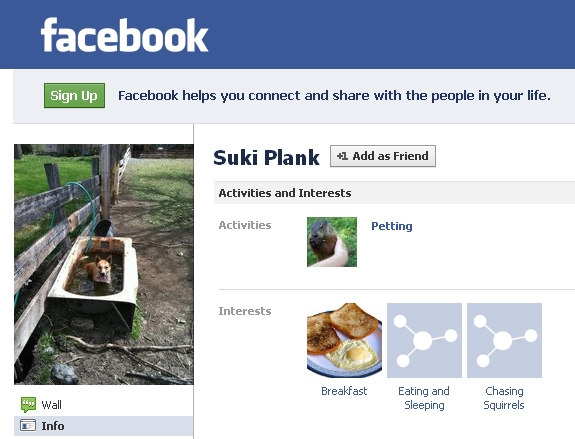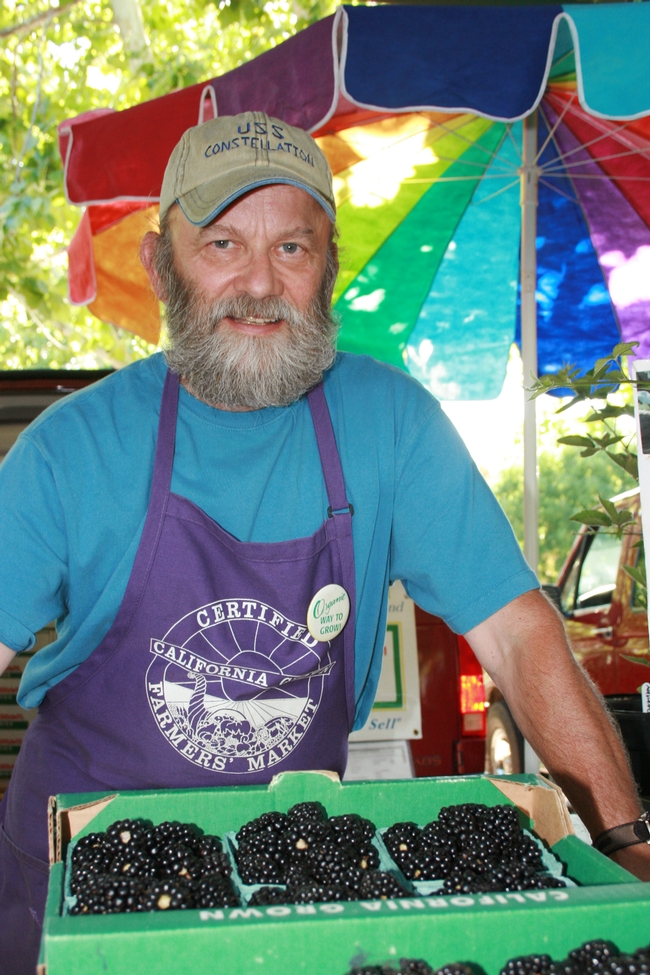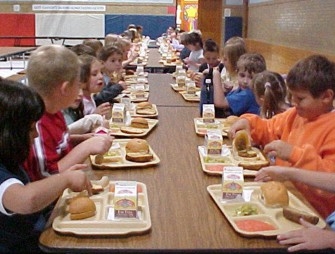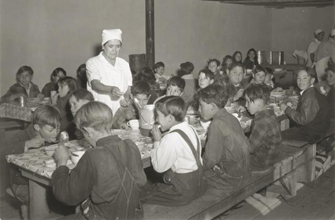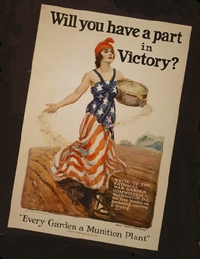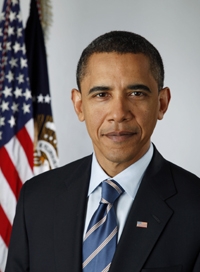Posts Tagged: USDA
One more way to 'know your farmer'
A ranch dog "friended" me on Facebook the other day. Yep, a dog on Facebook. To be specific, this is a working dog on a ranch that produces meat and sells it directly to consumers like me.
Apparently when Suki isn't herding cows at Scott River Ranch, she's surfing the web.
And exactly how is a ranch dog on Facebook related to food?
More and more people are interested in connecting with farmers and ranchers who produce the food we eat.
If you buy fresh produce at a farmers market, you can also ask farmers (or their employees) questions about which variety is ripest right now, how the produce was grown, how the meat was processed, and what the farm is like. Proactive eaters can sign up for CSA harvest boxes to receive seasonal produce, know exactly who is growing their food, and pledge support to a particular farm or group of farms. We can visit farms to participate in agritourism by buying from farm stands, taking ranch tours and even getting into the fields to harvest "U-pick" berries and other fruit.
"Local is hot" was on one of the opening slides of Kathleen Merrigan's presentation at UC Davis last week. The USDA's deputy secretary was visiting campuses to discuss the agency's "Know Your Farmer, Know Your Food" campaign, which focuses on local and regional food system support.
And now we have another way to know a farmer, without even leaving the office: Anyone can like their favorite farmers on Facebook, follow them on Twitter, subscribe to their blogs, sign up for their email newsletters, and more.
Hearing about Suki the ranch dog's antics, with photos of her bathing in a water trough or videos of her chasing a field's pivot sprinklers, is another way for consumers to get a glimpse of ranch life from behind the scenes. Likewise, hearing from a farmer on Facebook about how today's rain might affect the cherry harvest is another way for me to feel connected with the farmer who is raising food I will soon be eating.
Chris Kerston of Chaffin Orchards put it this way: "If I'm walking along the field and I see a weird-looking bug, I'm going to stop, take a picture of it with my phone, put it on Facebook and ask 'Anyone know what this weird bug is?' ... It's just another way for people to see what it's like out on the farm."
Don't take it just from me: National companies are taking notice too. This month the editorial board of The Packer, a newspaper that specializes in the fresh produce industry, suggested that local is also about something else:
"While some national suppliers may look skeptically at the buy local trend, a component of local is consumers’ need to connect with where their food comes from.
"Social media is often the solution."
You can connect with the farmers and ranchers who produce your food — whether you buy it at a farmers market or in a supermarket — and receive updates from the farm or ranch through social media.
You can start by asking your favorite farmers or ranchers if they're on Facebook, and here are a few other networks for finding farmers online:
- Know A California Farmer is a website that shares updates, blog posts and videos from participating farmers and ranchers.
- Find farms near you with the Local Harvest directory and see if they are online too.
- I also maintain a list of California farmers and ranchers on Twitter.
Join the discussion: So, what would you like to know from the people who grow and raise the food you eat?
Bonus video: Connecting with social media goes both ways; farmers want to connect with consumers who buy and eat their products. Staff and academics with UC Cooperative Extension and UC Davis have offered social media workshops to help farmers connect with consumers online (next one for me will be in Marin County, June 1). Here's a video after one UC workshop a few months ago:
Lunch ladies deserve the nation's support
The lunch lady at Cabrillo Middle School in Ventura, Calif., delivered the best commencement speech I’ve ever heard. In mid-June, Rita Pisani, whose passion is nourishing the bodies and spirits of people by preparing and serving them good food, spoke to more than 800 eighth-grade graduates and the well over 1,000 people who came to cheer them on.
Having a lunch lady be the featured speaker at an eighth-grade promotion might raise the eyebrows of some, but for this school and this school district, it makes sense. Cabrillo is part of the Ventura Unified School District, which operates farm-to-school salad bar programs at 17 campuses, and has gained national attention as an early adopter of farm-to-school and innovative nutrition programs. The farm-to-school program is part of the larger Healthy Schools Program, which also provides nutrition education and support for school gardens.
The choice of Rita Pisani as the person to deliver the parting words of wisdom to teens embarking on their high school journey also made a lot of sense in terms of a national context. With a White House supporting good food, gardening and obesity prevention initiatives, with the USDA sponsoring its People’s Garden Initiative, with farm-to-school and other good food advocates challenging the status quo with the school lunch program, it makes sense that someone like Mrs. Pisani – who has dedicated her life to feeding people, especially kids – should be heard. Food, after all – especially good food – is central to the health and well being of our youth and central to our success and security as a nation in the future.
Mrs. Pisani told a compelling story about a young girl. Born in wartime Italy, this girl’s hearing was severely damaged by bombing raids that occurred when she was very young. (The girl’s hearing loss was not fully diagnosed until she was 25; it was determined to be 80 percent in both ears, and she had surgery and was given hearing aids). Knowing that being “different” might result in limited opportunities for her daughter, the girl’s mother taught her how to read lips, analyze facial and eye expressions, and study gestures. As an eighth-grader the girl immigrated to the United States and was immersed in English-only classes, even though she spoke only Italian. A dedicated teacher spent two hours a day helping the girl learn English. The surprise ending? That girl was Rita Pisani, the lunch lady.
Mrs. Pisani shared her belief that this is exactly the time in life when these young people will have to make decisions, particularly about the kind of people they will be. And they are of an age where they will have to live with their choices. (And one choice she strongly encouraged them to make? Don’t cut in line!).
Some of the most important choices will center on how these teens choose to care for and nourish their bodies. As citizens and taxpayers, it’s in our best interest to make sure that good food choices in public schools are the norm, not the exception.
Lawmakers are taking action on the issue of childhood nutrition. Before its August recess, the Senate passed S3307 (the Healthy, Hunger-Free Kids Act), which would invest $4.5 billion into child nutrition. The clincher? It offset the proposed increase to childhood nutrition programs by suggesting a $2.2 billion reduction in the SNAP (formerly Food Stamps) program, where need is growing due to the nation’s dire economic situation. Over the summer, the House Education and Labor Committee passed HR 5504 (Improving Nutrition for America’s Children Act), which would invest $8 billion in childhood nutrition; however, the bill is stalled, because funds to pay for this have not been located.
The Childhood Nutrition Reauthorization Act, a major omnibus bill, includes numerous components, and is also stalled in Congress. It is renewed on a five-year cycle; Congress should have renewed it in 2009, but the national dialog about health care delayed discussion and passage. The bill has been extended until Sept. 30, 2010. It encompasses the National School Lunch Program; the School Breakfast Program; the Child and Adult Care Food Program; the Summer Food Service Program; Women, Infants and Children (WIC), including, the WIC Farmers’ Market Nutrition Program; the Fresh Fruit and Vegetable Program; and the Special Milk Program. Because the Act is so large and comprehensive, it’s important for citizens to learn more about it and its components. Information is available at www.schoolnutrition.org/Content.aspx?id=2402
All of the legislation described above affects children and lunch ladies across the nation, lunch ladies like Mrs. Pisani. I have considered Mrs. Pisani’s words over and over the last few months. As she concluded her remarks, she told Cabrillo students, “I love to cook for people and serve them food. This is my passion. I have done it as a head chef, restaurant owner and caterer most of my life. This is why now I am happy to be your lunch lady.” Cabrillo’s principal, Glory Page, made an important observation about Mrs. Pisani: “She serves food, but more importantly, she serves kids.”
Lunch ladies do serve kids, in all sorts of ways. I loved my lunch lady, Mrs. Ketchell, who helped us work through challenges and life problems by engaging us to work alongside her in the cafeteria at Joshua Elementary School. The privilege of working in the cafeteria was reserved for older students. We couldn’t wait for our week to help prepare and serve food, and clean the cafeteria after lunch. It connected us to caring adults, it instilled in us a work ethic, it honored the collaborative and community nature of food preparation and eating, it enabled us to serve other students and it connected us to our food.
Times have changed, but the hearts of lunch ladies haven’t. It’s up to us to make it possible for them to even more effectively serve kids by giving them the money they need to serve those kids good food. The choice of commencement speaker couldn’t have been better or more relevant to this national moment. Thank you, Mrs. Pisani, for great lunches and great lessons.
Summon us to service
For more than a hundred years, gardening has been linked to service in American communities. Reformers used school and community gardens to improve aspects of urban life, to educate children, to feed the hungry, to provide training to those facing economic challenges. Today, the University of California models service through gardening via its Master Gardener Program, which fields thousands of highly trained gardens who provide support for school, home and community gardens across the state.
Our nation has many needs right now. Families are economically insecure. (This is an understatement). Communities are food-insecure. Obesity is epidemic; the figures on childhood obesity are particularly disturbing. We have a tenuous connection with the land and a poor understanding of our food system. Environmental concerns - and declining oil supplies - dictate a need to recreate more sustainable and local food systems. Despite the bad news, Americans have proven that they are hungry for change, eager to re-engage with their neighbors, their communities and their nation.
A revival of the successful national gardening programs (Victory Gardens) of the past is clearly occurring. Gardening and the local food movement are hot topics. And consider the USDA’s Peoples Garden Initiative (PGI), which was launched in 2009, on the biennial of Abraham Lincoln's birthday. (This was fitting: President Lincoln created the USDA and felt strongly that Americans needed to know how to cultivate land - even small parcels - to keep freedom secure).
The PGI is making good progress across the nation: there are now Peoples Gardens in every state. If encouraged and supported by us, the PGI could help in myriad ways. The infrastructure for the program is already in place. The educational materials that support school, home and community gardens are available through existing government agencies and private organizations. And, as I suggested to Agricultural Secretary Tom Vilsack via the Huffington Post, thousands of highly-trained volunteer Master Gardeners (who serve under the USDA’s umbrella, through land grant institutions) can be called upon to share their expertise with school, home and community gardeners.
I’ve said it before, and I’ll say it again: all President Obama needs to do is ask. Help us once again engage Americans in service to nation through gardening. Summon us to service. Come out to your garden, admit to us that that we’re experiencing rough times, but tell us that we can make a difference by acting locally - through the simple act of gardening. Encourage those who can to plant a garden to do it. Summon us to service: Ask us to plant for our families and our communities, to grow a row for the hungry, to share any extra produce with food banks.
Mr. President, we’re hungry for change (and a shameful number of Americans are just plain hungry). Sometimes to move forward, we must look back for inspiration. Certainly, the Victory Gardens of the past provide a wonderful example of what ordinary citizens can accomplish on the home front to respond to challenges in the larger world. The revival of a national Victory Garden campaign can provide the kind of change we can dig into, some good news we can all use right now.
I can’t miraculously create millions of jobs, or clean up the oil currently in the Gulf, but I can facilitate the small miracle of growing and providing fresh produce to my family, and perhaps sharing it with those who are experiencing hunger in my community. Please, Mr. President: Summon us to service.
Victory Gardens: A boon in hard times
I collect gardening catalogs. To me, they represent life and productivity and the promise of family, good food and good health. They also provide a link to a simpler, agrarian past that I find comforting and restorative in these unsettling times. In a world where oil gushed into the Gulf of Mexico, violence seems unchecked, compassion towards the less fortunate seems to have evaporated and economic misery abounds, I find gardening catalogs a refuge of optimism. We need fewer bad things in this world and more good gardens.
I’ve spent more time this year sitting in the chair in my garden in the evening, thinking about what this small cultivated area says about these times, this world and my life. I’ve resisted buying many seeds this year; like others, the economy gives me jitters. Not that I’m without hope about the economy or the potential of gardens in this current presidential administration. Especially the latter, as the residents of the White House look favorably on sustainable and local food systems. Like our family, the first family has a garden on the front lawn. What’s more affirming than a front yard garden in hard times like these?
In hard times, Americans have always turned to gardening.
The Victory Gardens of World War I and World War II - and the garden efforts of the Great Depression - helped Americans weather hard times. These gardens helped the family budget, improved dietary practices; reduced the food mile and saved fuel, enabled America to export more food to our allies, beautified communities, empowered every citizen to contribute to a national effort, and bridged social, ethnic, class and cultural differences during times when cooperation was vital. Gardens were an expression of solidarity, patriotism and shared sacrifice. They were everywhere...schools, homes, workplaces and throughout public spaces all over the nation. No effort was too small. Americans did their bit. And it mattered.
Consider this: In WWI, the Federal Bureau of Education rolled out a national school garden program and funded it with War Department monies. Millions of students gardened at school, at home, and in their communities. A national Liberty Garden (later Victory Garden) program was initiated that called on all Americans to garden for the nation and the world. The success of home gardeners (and careful food preservation) helped the U.S. increase exports to our starving European Allies.
The WWII experience was equally successful. During 1943, some polls reported that three-fifths of Americans were gardening, including Vice President Henry Wallace, who gardened with his son. That same year, according to some estimates, nearly 40 percent of the fresh fruits and vegetables consumed stateside were grown in school, home and community gardens. In addition to providing much-needed food, gardening helped Americans unite around a positive activity. Gardens gave all Americans a way to provide service to the nation, enabling citizens on the home front to make significant contributions to the war effort.
Our nation again finds itself in challenging times. School, home and community gardens provide a way to respond positively to this period of uncertainty and change.
Editor's note: Join the author of this post, Rose Hayden-Smith, for a web presentation about the Victory Garden movement at 9 a.m. July 28.
Hayden-Smith will review historical case studies of Victory Gardens and current national policies and models. She will also discuss the future work needed to sustain the Victory Garden model as part of the overall local food movement. To wrap up the hour-long webinar, she will discuss urban agriculture and how the local food-systems movement is addressing a wide range of challenges facing Americans today.
Space is limited. Click here to reserve a webinar spot.


